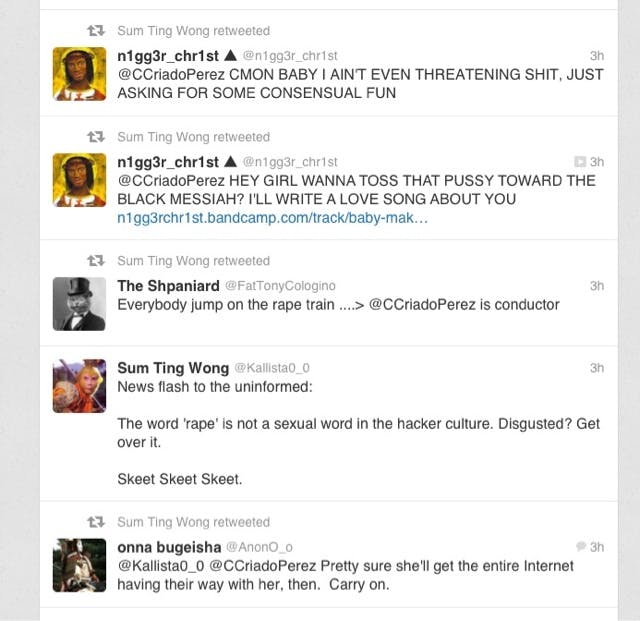Death threats, rape threats, and misogynist hate mail. If you’re a woman who likes to express her opinion on the Internet, it may seem like these things are unavoidable. Just ask Anita Sarkeesian.
But this week may have been the final straw when it comes to Twitter’s sexist hate mail problem. After feminist campaigner Caroline Criado-Perez received 50 rape threats in an hour, people began to sit up and take notice: The threats were plain to see, and Twitter didn’t seem to be doing anything about it.
So, what did Criado-Perez do to inspire this level of vitriol? Not even anything particularly controversial: She’d led a campaign for a woman to be put on British banknotes.
The campaign had been going on for months, but last week the Bank of England finally chose which woman would be joining all those famous historical men on previous £10 notes: Jane Austen. As the leader of the campaign, Criado-Perez should’ve been celebrating, but instead she found herself in the middle of a storm of Twitter abuse from guys who just couldn’t deal with … well, it’s not entirely clearly what they couldn’t deal with, except maybe “women saying things on the Internet.”

Screencap via iwillnotputupwiththis
Criado-Perez began to retweet the threats, explaining that Twitter’s current “block and ignore” strategy was no help in situations like this; Twitter needed to install a “report abuse” button.
This idea quickly gained support from prominent feminists such as Laurie Penny and Caitlin Moran—many of whom had been the target of Twitter abuse themselves. A Change.org petition was set up, along with the idea of a “Twitter boycott” on Aug. 4—although some people are already commenting on the irony of this idea:
It’s not just me who doesn’t quite get the idea of a day of women’s silence on twitter to protest against women being silenced, is it?
— Kellie Hill (@BigFashionista) July 27, 2013
BOYCOTT TWITTER cry the Noble Journalists Of Major Publications. WE WILL NOT BE SILENCED they scrawl in their nationally published columns
— rupert spurrier (@Rspurrier25) July 27, 2013
Of course, many Twitter users have been pointing out that feminists such as Caitlin Moran and Suzanne Moore remained suspiciously silent when this kind of abuse was aimed at women who weren’t part of their own white, middle-class, gender-normative demographic. Most of the high-profile feminists publicizing the boycott are not known for their support of minorities or transwomen, and are therefore unlikely to gain many followers among the Tumblr/Twitter community of intersectional feminists. In fact, Moore stirred up controversy just a few months ago by tweeting a transphobic rant to her 35,000 followers. If a “report abuse” button was added, it’s highly likely that she would end up being reported herself.
No issue is a problem for liberals until it happens to People Like Them.
— Paul McMc (@panthersolo) July 27, 2013
Jesus fucking Christ. Not a clue. RT @thwphipps: The Future Of Politeness On Twitter pic.twitter.com/j1mmkNRfYo
— nobrightside (@nobrightside) July 27, 2013
The question is, would a “report abuse” button be a viable solution for Twitter’s abuse problem? First of all, how could Twitter prevent people from misusing it? While people like Caroline Criado-Perez would find it easier to report abuse if each account came with a ready-made report button, her detractors would also be able to do the exact same thing. It would be the perfect way for trolls to set up a kind of Twitter-based DDoS attack on their targets.
At the moment, Twitter’s help center includes a form where you can fill out the details of a particular harasser. Additionally, users are advised to block abusive accounts and contact law enforcement if they feel like they’re in danger. But for people who are receiving as many abusive messages as Criado-Perez, this may not always be a practical option. If the abuse kept up at its current rate, she’d have to spend hours or days on the line with Twitter’s help center.
The good news is that Twitter is already working on a new anti-abuse system: a “report tweet” button, which is currently available to iPhone users and, according to a Twitter spokesperson, will soon be available on other platforms. However, it’s unclear how this will be any more efficient than the current system when it comes to removing abusive accounts entirely. The ability to report individual tweets leaves users like Criado-Perez open to false accusations from trolls, meaning that all reports will presumably have to be looked over by an actual human rather than being automatically blocked or deleted. And there will be a lot of abuse reports to read through.
Guardian gets 600,000 comments/month & employs c. 12 FTE Moderators. Twitter gets 400,000,000 tweets per day (12 billion/month). Impossible.
— Greg Callus (@Greg_Callus) July 27, 2013
As of this spring, 400 million tweets are posted every day. Between people reporting valid abuse and others using the “report tweet” button as a weapon during online disputes,Twitter would need hundreds of new employees or volunteer moderators just to sift through all the reports. And, of course, once one troll account has been banned, it only takes a couple of minutes to set up a new one and start sending abusive tweets all over again.
Although reporting criminal threats to the police has already led to one arrest in this particular case, Criado-Perez and her supporters still argue that Twitter is not doing enough to deal with its abuse problem. However, the 43,000 people who signed the “report abuse” petition are likely to end up disappointed. It’s nice to imagine a world where people could instantly deal with every threatening tweet on the site, but the ability to instantly report all abusive accounts may not be a practical option.
Art by Jason Reed


